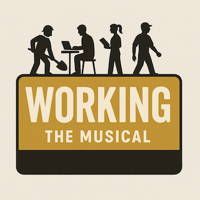
Working
Musical
Writers:Stephen Schwartz Nina Faso Craig Carnelia Mary Rodgers Lin-Manuel Miranda Micki Grant Susan Birkenhead
Overview
Synopsis
Working is a musical mosaic that captures the hopes, dreams, struggles, and pride of the American workforce. Adapted from Studs Terkel’s landmark oral history, the show presents a diverse group of characters—from teachers, waitresses, and steelworkers to corporate executives, truck drivers, and housewives—each reflecting on the meaning and value of their labor. Through a series of vignettes and songs, these everyday people share what motivates them, what frustrates them, and how their work shapes their sense of identity and purpose.
The musical unfolds without a traditional plotline, instead weaving together heartfelt monologues and songs into a deeply human tapestry. Each story is personal and intimate, yet collectively they reveal a universal truth about dignity, ambition, and the shared experience of making a living. Over time, Working evolves into a celebration of resilience and connection—reminding audiences that behind every job title lies a story worth hearing.
Show Information
Context
Working premiered in 1978 during a time of significant social and economic change in the United States. The country was still feeling the aftershocks of the Vietnam War, the civil rights movement, and the rise of feminism, all of which redefined what it meant to “make a living.” Inspired by Studs Terkel’s groundbreaking 1974 oral history Working: People Talk About What They Do All Day and How They Feel About What They Do, the musical sought to give voice to everyday Americans whose stories
to read the context for Working and to unlock other amazing theatre resources!Plot
Characters
| Name | Part Size | Gender | Vocal Part |
|---|---|---|---|
|
Supporting |
Male |
Baritone |
|
|
Supporting |
Female |
Mezzo-Soprano |
|
|
Supporting |
Female |
Mezzo-Soprano |
|
|
Supporting |
Male |
Tenor |
|
|
Supporting |
Female |
Mezzo-Soprano |
|
|
Supporting |
Female |
Mezzo-Soprano, Alto |
|
|
Supporting |
Male |
Baritone |
|
|
Supporting |
Male |
Tenor |
|
|
Featured |
Female |
Mezzo-Soprano, Alto |
|
|
Featured |
Female |
Mezzo-Soprano |
|
|
Featured |
Male |
Baritone |
|
|
Featured |
Female |
Alto |
|
|
Featured |
Male |
Baritone |
|
|
Ensemble |
Not Specified |
|
Songs
Act I
Act II
A song with an asterisk (*) before the title indicates a dance number.
Monologues
Scenes
Key Terms
Docudrama is a genre that blends factual events or real-life interviews with dramatic storytelling techniques. It seeks to present truth through a theatrical or cinematic lens, combining authentic dialogue or situations with interpretive performance. The goal is to engage audiences emotionally while maintaining a foundation in reality and historical accuracy.
Naturalism is a theatrical style that seeks to depict life with accuracy, focusing on everyday speech, behavior, and settings. It often highlights ordinary people in realistic environments, emphasizing authenticity over theatricality. Emerging in the late 19th century, naturalism remains influential in contemporary drama.
A form of theatre with a series of short sketches, songs, and dances, often satirical and lacking a unified narrative.
A movement and technique using symbolic imagery and metaphors to express abstract ideas and inner experiences.
A tableau is a staged moment where performers freeze in a visually powerful pose or arrangement, almost like a living picture. Instead of dialogue or movement, the image itself communicates the meaning—whether it’s celebrating triumph, mourning loss, or showing a turning point in the story. In an opera such as Ça Ira, which dramatizes the French Revolution, tableaux are often used to symbolize big events like the storming of the Bastille or the collective spirit of the people.
A vignette in drama is a short, self-contained scene or playlet that focuses on a single moment, theme, or character interaction. It does not require a full plot or complex structure, but instead provides a snapshot of life that conveys emotion, humor, or insight. Vignettes can stand alone or be grouped together to form a larger work.
Videos
Quizzes
Themes, Symbols & Motifs
Themes
The Dignity of Labor: At the heart of
to read about the themes, symbols and motifs from Working and to unlock other amazing theatre resources!Quote Analysis
Sorry! We do not currently have learning modules for this guide.